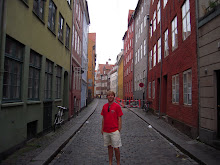
Lang also takes advantage of sound. Most chilling is Beckert’s whistling of “In the Hall of the Mountain King”, which is the ultimate reason for Beckert’s capture (made by, ironically, enough, a blind man: one of the many aspects of Lang’s larger commentary about the efficiency of the police.) Lang uses sound—or, rather, lack thereof—to heighten the child killer’s violent libido when he stares at sets of knives (his weapons) and the reflection of a young girl in the mirror of a store window. The sound of the hustle and bustle in the streets fades off, and the silence is almost louder than noise. Presented in front of the killer are the two things he lusts most for: weapons and a fresh, young victim. When Beckert screams to the underworld at the film’s close that “I want to escape, to escape from myself! But it’s impossible. I can’t escape. I have to obey it,” the audience understands, as they have already witnessed Beckert unable to control his horrifying desires.
Lang also interconnects the murders and Beckert’s insanity with strong and recurring visual cues; when he tracks down the victim he sees in the store reflection, he briefly passes a window with a bouncing arrow. This reminds the viewer of the ball Elsie bounced at the beginning of the film. To the right of the arrow is a hypnotic, black and white swirl, denoting Beckert’s lack of self-control and forward the idea that he is under a sort of id-driven spell. The placement of the two items—the arrow in the left half and the swirl in the right—is the exact placement of Elsie’s ball and Beckert’s shadow when the two characters meet. The swirl also visually connects with the empty and barren staircase that leads up to the Beckmann’s apartment: both give off an optical illusion that jars the viewer.

“It’s me, pursuing myself,” Beckert screams to the underworld. What an incredibly apt way to describe his insanity as well as Lang’s process. Not only does this line link with Beckert’s shadow—how he was first presented to the audience—but also sums up the film’s central purpose: the character’s and the audiences’ pursuit of Beckert. The camera jumps and cuts to different physical locations, mirroring the thoughts of the characters during the investigation. M is a remarkably early example of how the camera interprets the power of the mind.

No comments:
Post a Comment